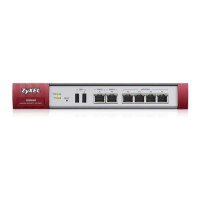Chapter 44 Anti-Spam
ZyWALL Series CLI Reference Guide
405
event when an e-mail matches the DNSBL (see Section 44.2.3 on page 407 for more on DNSBL). The
white and black lists are ignored.
44.2.2 White and Black Lists
The following table identifies values used in these commands. Other input values are discussed with the
corresponding commands.
Router(config)# anti-spam 1
Router(config-as-rule-1)# activate
Router(config-as-rule-1)# scan smtp
Router(config-as-rule-1)# scan pop3
Router(config-as-rule-1)# match-action smtp forward
Router(config-as-rule-1)# match-action pop3 forward-with-tag
Router(config-as-rule-1)# log
Router(config-as-rule-1)# bypass white-list
Router(config-as-rule-1)# bypass black-list
Router(config-as-rule-1)# exit
Router(config)# show anti-spam 1
Anti-Spam Rule: 1
profile name: AS_profile_default_SXI
description:
log: log
scan protocols:
smtp: yes
pop3: yes
match action:
smtp: forward-with-tag
pop3: forward-with-tag
bypass white list: no
bypass black list: no
bypass ip reputation: no
bypass mail content: no
bypass virus outbreak: no
bypass dnsbl: no
ref: 0
Table 216 Input Values for White and Black list Anti-Spam Commands
LABEL DESCRIPTION
mail_header
The name part of an e-mail header (the part that comes before the colon). Use up to
63 ASCII characters.
For example, if you want the entry to check the “Received:” header for a specific mail
server’s domain, use “Received”.
mail_header_value
The value part of an e-mail header (the part that comes after the colon). Use up to 63
ASCII characters.
For example, if you want the entry to check the “Received:” header for a specific mail
server’s domain, specify the mail server’s domain.
See Section 44.2.2.2 on page 407 for more details.
rule_number
The index number of an anti-spam white or black list entry. 1 - X where X is the highest
number of entries the Zyxel Device model supports. See the Zyxel Device’s User’s Guide
for details.
subject
A keyword in the content of the e-mail Subject headers. Use up to 63 ASCII characters.
Spaces are not allowed, although you could substitute a question mark (?). See
Section 44.2.2.2 on page 407 for more details.

